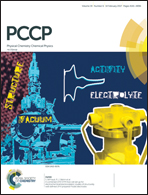Spectroscopic investigation of bio-mimetic solvolysis of 6-(N,N-dimethylamino)-2,3-naphthalic anhydride in confined nanocavities†
Abstract
Enzymes are biological catalysts that can vastly accelerate the reaction rate of a substrate by accommodating it within the active site. The local environment provided by the active site of a natural catalyst causes a significant rate-enhancement of the reaction as compared to that without catalyst. The solvolysis reaction of a 6-(N,N-dimethylamino)-2,3-naphthalic anhydride probe is investigated using UV-Vis and fluorescence spectroscopy in pure alcohols and in bio-mimetic nano-sized environments like surfactants, macrocyclic hosts and protein nanocavities. The solvolysis rate in alcohols is found to be regulated directly by the alkyl chain length and follows Arrhenius dependence. The hydrolysis rate of the probe in water under physiological conditions (pH 7.4, at 25 °C) is very slow. However, under identical conditions, the rate can be accelerated significantly by protein and supramolecular nanocavities. Therefore, such fundamental kinetic analysis of the understanding of this bio-mimetic solvolysis will allow us to design a novel probe–drug conjugate with efficient controlled-release and function.



 Please wait while we load your content...
Please wait while we load your content...